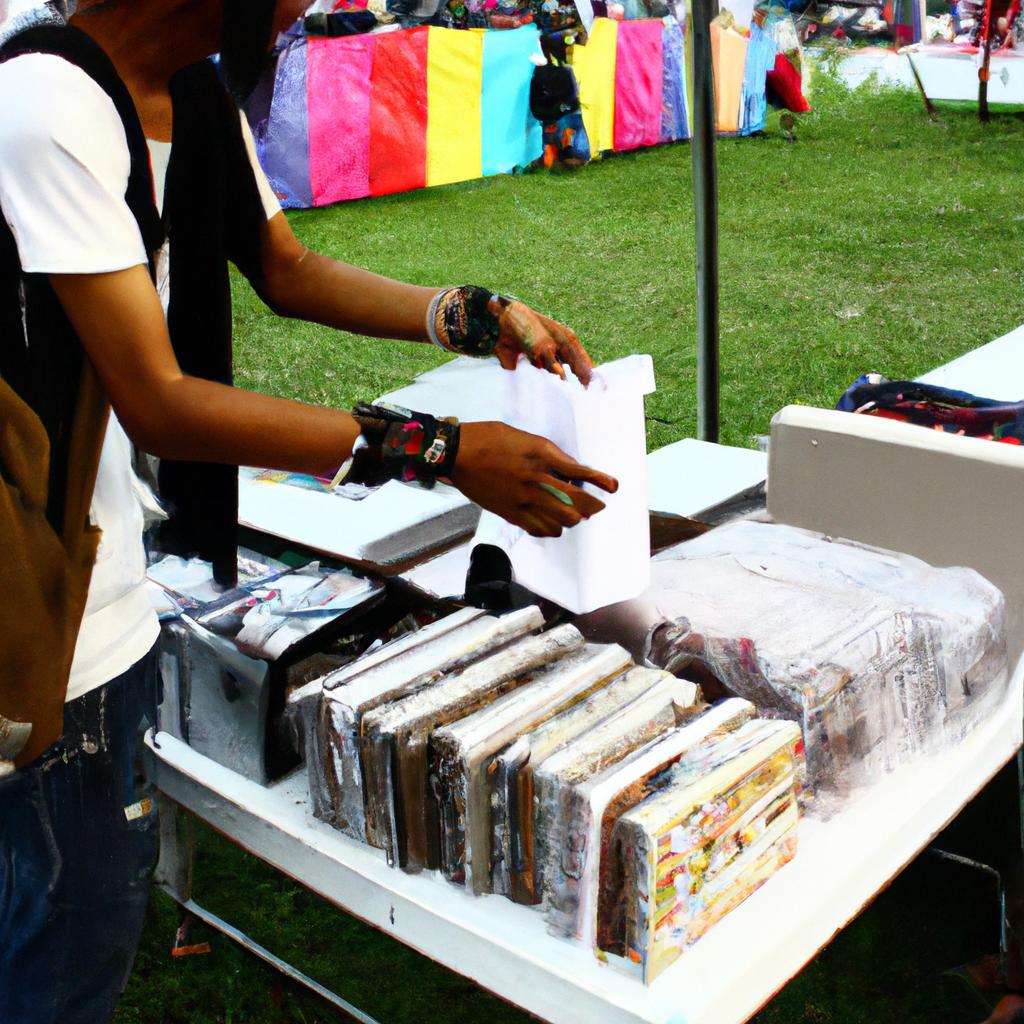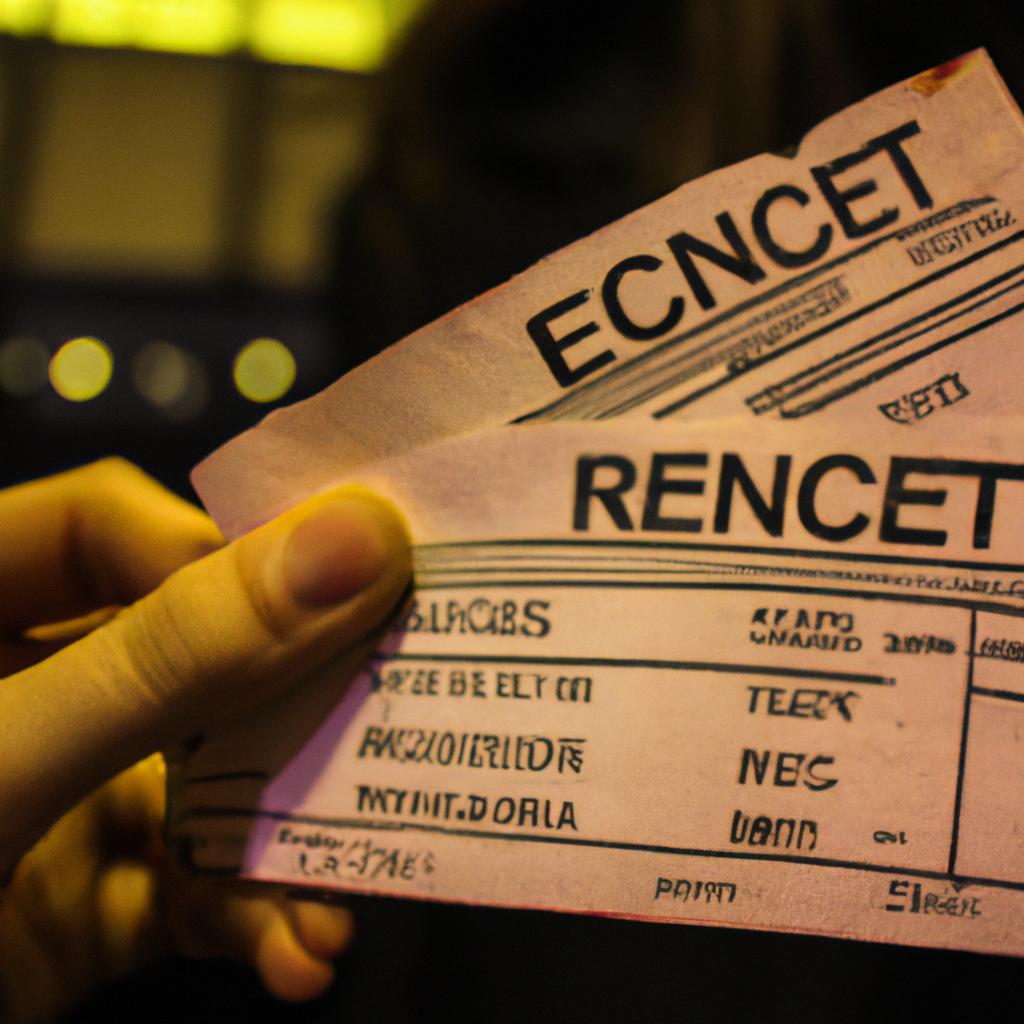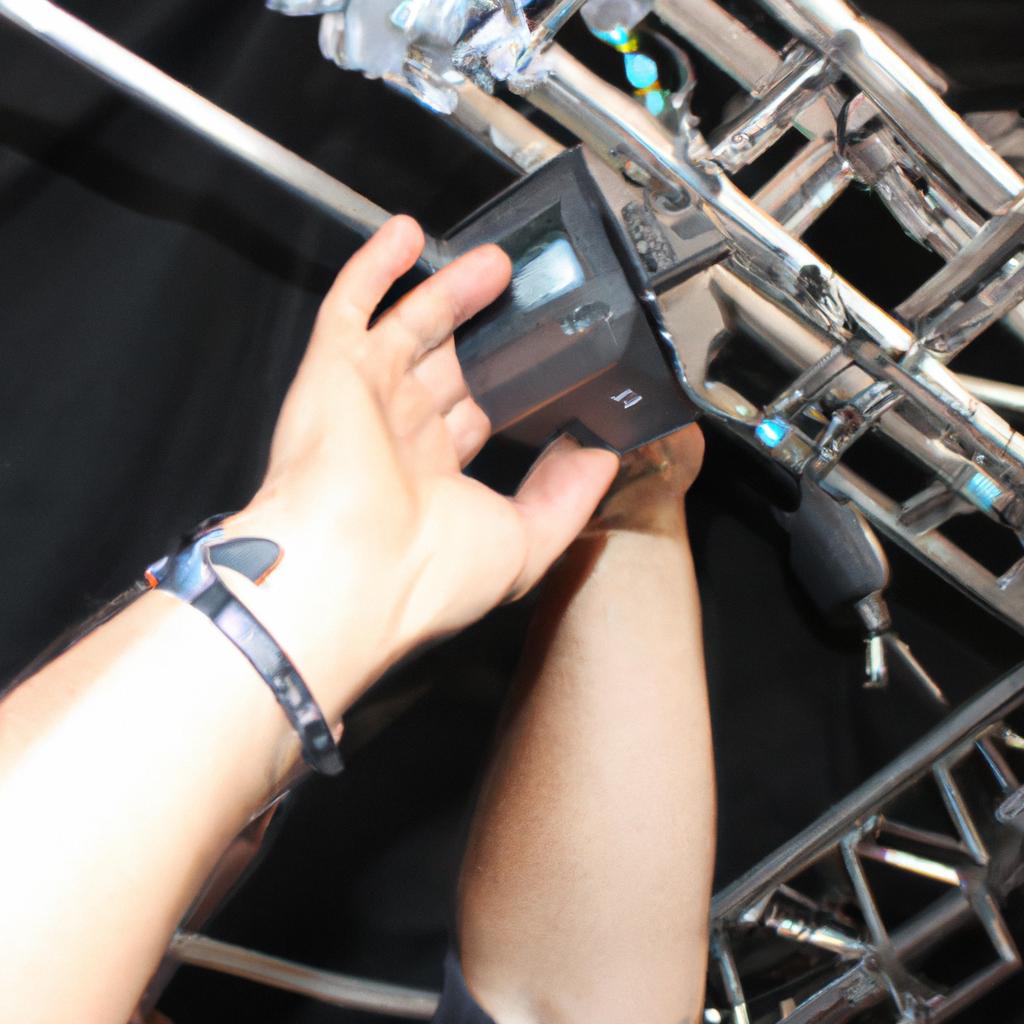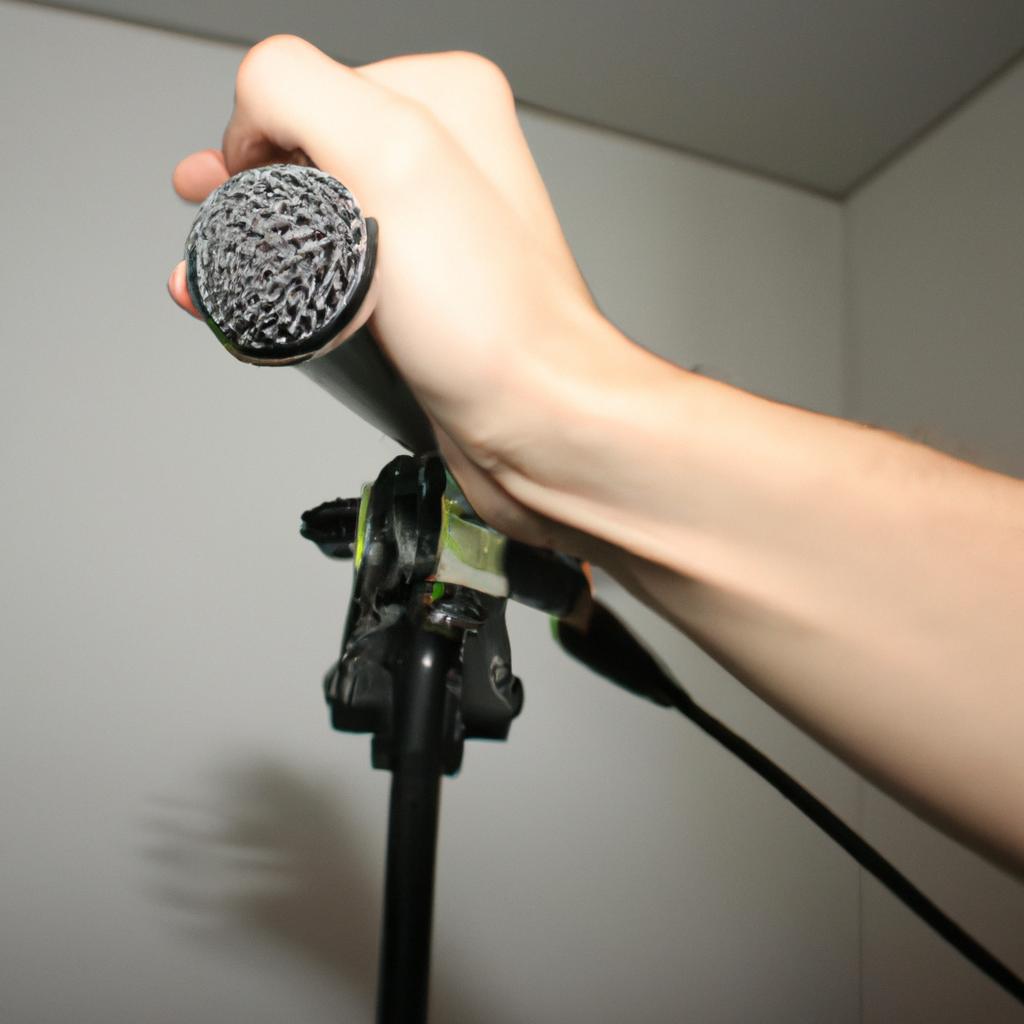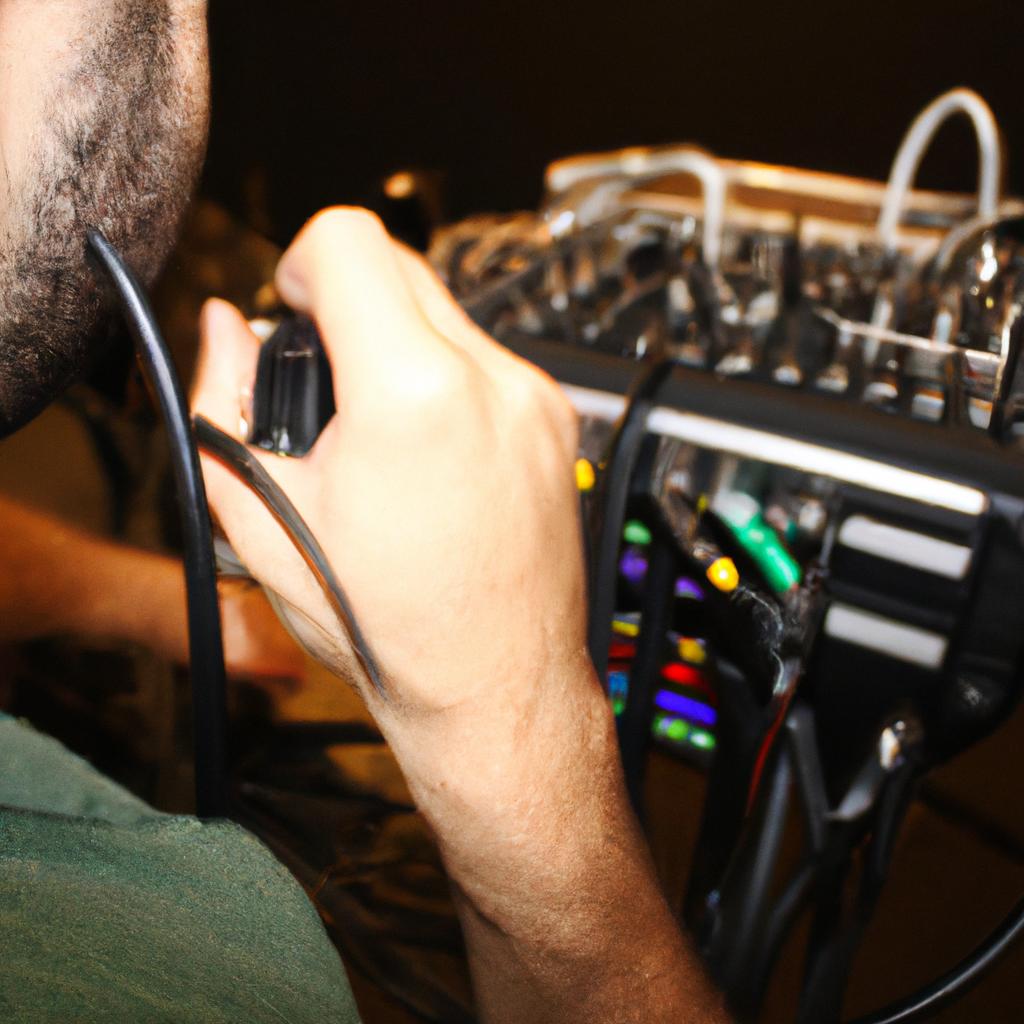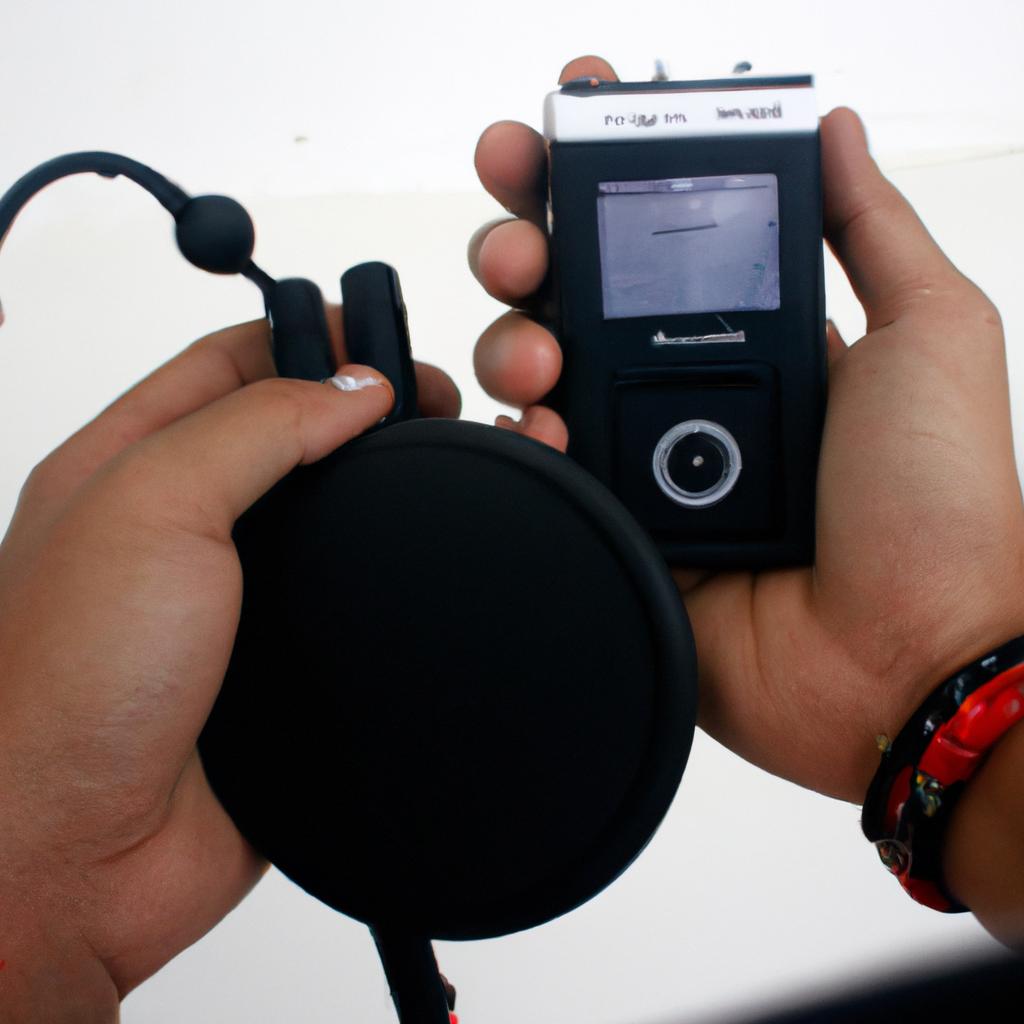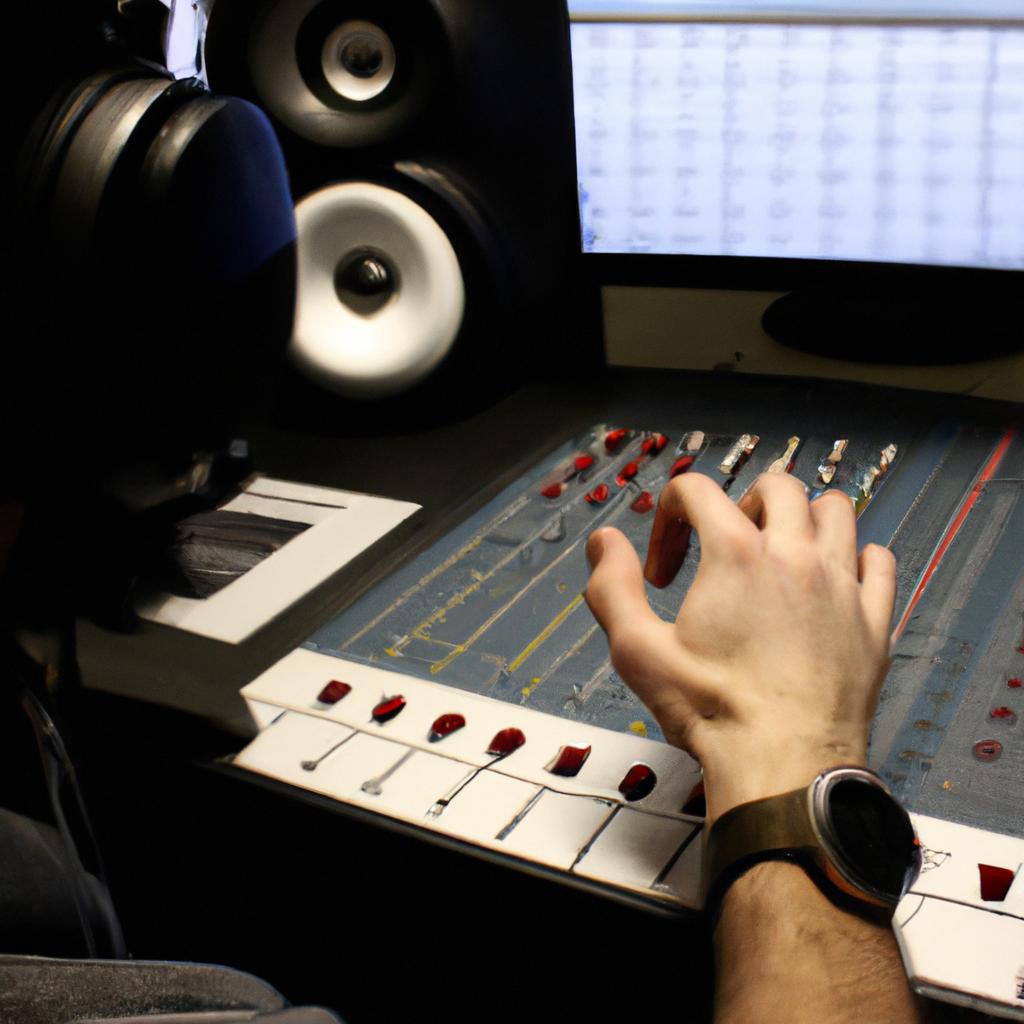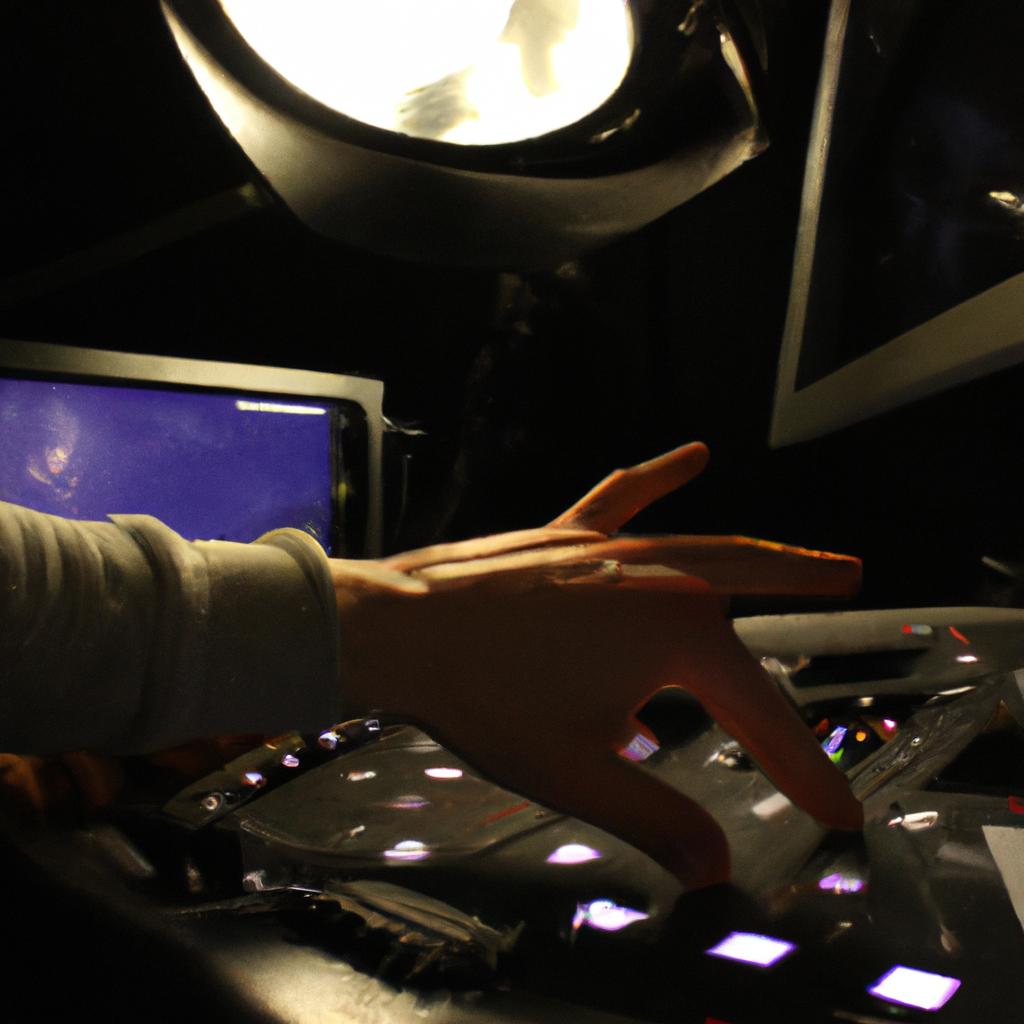Concert merchandise has become an integral part of the music industry, serving as a unique avenue for artists to extend their brand beyond the stage. This article explores the phenomenon of concert merchandise through the lens of sound and vision, examining how these products not only provide fans with tangible mementos but also serve as powerful marketing tools. To illustrate this point, let us consider the case study of a hypothetical band called “Soundwave.” Soundwave’s successful tour is characterized by their distinctive blend of rock and electronic elements, captivating audiences worldwide. As they take to stages around the globe, their carefully designed concert merchandise acts as both a sonic representation of their music and a visual extension of their artistic identity.
In recent years, concert merchandise has witnessed a significant evolution in terms of its design and impact on fandom culture. Gone are the days when t-shirts adorned solely with band logos sufficed; now, fans seek out visually striking garments that embody the essence of their favorite artists’ performances. The emergence of new printing techniques and innovative designs allows musicians like Soundwave to create concert apparel that reflects the sensory experience of their live shows. Through intricate graphics, vibrant colors, and clever typography, these pieces aim to capture the energy and atmosphere felt during concerts while simultaneously resonating with the personal style and tastes of their fans.
For Soundwave, the concert merchandise goes beyond just being a visual representation of their music. It also serves as a sonic extension of their sound. The band carefully selects materials that enhance the tactile experience for fans, incorporating elements such as textured fabrics or embossed details that mimic the dynamic nature of their music. Additionally, they collaborate with sound engineers to embed audio snippets from their performances into select merchandise items, such as limited edition vinyl records or interactive clothing pieces. This innovative approach allows fans to carry a piece of Soundwave’s live shows wherever they go, creating an intimate connection between the band and its audience.
Furthermore, concert merchandise has become a powerful marketing tool in today’s digital age. Social media platforms have transformed fan culture, enabling artists to reach a global audience instantly. Concert apparel acts as a walking advertisement, allowing fans to proudly display their support for Soundwave and spark conversations among like-minded individuals online and offline. By designing unique and eye-catching merchandise, Soundwave not only reinforces brand loyalty but also attracts new listeners who are intrigued by the visual appeal of their products.
In conclusion, concert merchandise has evolved into more than mere memorabilia; it is now an art form that encapsulates both sound and vision. Bands like Soundwave leverage this phenomenon to engage with fans on multiple sensory levels while simultaneously expanding their reach in the music industry. As technology continues to advance and fan expectations evolve, concert merchandise will undoubtedly continue to push creative boundaries and serve as an essential component of the live music experience.
The Evolution of Concert Merchandise
Concert merchandise has come a long way since its inception, evolving alongside the music industry and reflecting changing consumer preferences. To illustrate this evolution, let us consider the case study of a hypothetical rock band called “Sound and Vision.” In their early days, Sound and Vision offered basic concert merchandise such as t-shirts featuring their logo and album artwork. These items served as souvenirs for fans to commemorate their attendance at live shows.
Over time, concert merchandise has become an essential part of the fan experience. The demand for more diverse and unique products has increased, prompting artists like Sound and Vision to expand their offerings beyond traditional apparel. Today, concertgoers can find an array of exclusive items that cater to different tastes and interests. For instance:
- Limited edition vinyl records: Music enthusiasts are drawn to these collectible pieces not only for their audio quality but also for the sentimental value they hold.
- Customized accessories: From keychains to phone cases adorned with band logos or lyrics, fans seek out small mementos that allow them to display their dedication in everyday life.
- Artist collaborations: By partnering with renowned designers or other musicians, bands like Sound and Vision create special edition merchandise that merges fashion with fandom culture.
- Interactive experiences: Some concerts now offer virtual reality headsets or augmented reality apps that provide fans with immersive experiences related to the artist’s music.
To further emphasize the changes in concert merchandise trends over time, we present a table showcasing three distinct eras:
| Era | Main Product Offerings | Key Feature |
|---|---|---|
| 1980s | T-shirts | Simple designs; often limited color options |
| Early 2000s | Hoodies | Emphasis on comfort; integration of album artwork |
| Present day | Diverse range | Wide variety catering to individual preferences; limited edition releases |
As the music industry continues to evolve, artists have a significant influence on concert merchandise. This will be explored further in the subsequent section, “The Influence of Artists on Concert Merchandise.” By understanding this evolution and its impact on the fan experience, we can gain insights into how concert merchandising has become an integral part of modern-day live performances.
The Influence of Artists on Concert Merchandise
Concert merchandise has come a long way over the years, evolving from simple t-shirts and posters to becoming an integral part of the concert experience. Artists and their teams have recognized the power of merchandise not only as a source of revenue but also as a means to connect with fans on a deeper level. This section will explore how concert merchandise has evolved into more than just products for sale, but rather items that represent sound and vision.
One example of this evolution can be seen in the case of Beyoncé’s Formation World Tour in 2016. Alongside traditional items such as t-shirts and hats, Beyoncé introduced a range of unique merchandise that reflected the themes and messages conveyed through her music and performances. Items like phone cases featuring lyrics from her songs or sweatshirts adorned with powerful imagery created a sense of exclusivity and personal connection for fans who purchased them.
To further understand the impact of concert merchandise on fans, consider these emotional responses evoked by different types of merchandise:
- Excitement: Fans eagerly wait in line to get their hands on limited edition tour posters.
- Nostalgia: A fan proudly wears their vintage band t-shirt, reminiscing about past concerts.
- Identity: Wearing an artist’s logo becomes a symbol of belonging to a community.
- Support: Purchasing official merch is seen as directly supporting artists’ careers.
Table: Emotional Responses Evoked by Concert Merchandise
| Emotion | Example |
|---|---|
| Excitement | Limited edition tour posters |
| Nostalgia | Vintage band t-shirts |
| Identity | Artist logo apparel |
| Support | Official merch purchases |
In conclusion, concert merchandise has transformed from mere products into tangible representations of sound and vision. Through creative design choices, artists are able to convey messages beyond their music, creating deeper connections with fans. This evolution has allowed for a more immersive concert experience, where fans can proudly display their love and support for their favorite artists. Moving forward, the impact of technology on concert merchandise will be explored in the next section.
As concert merchandise continues to evolve, it is important to consider how advancements in technology have shaped this industry. The Impact of Technology on Concert Merchandise will shed light on the ways digital platforms and innovations have influenced the creation, distribution, and consumption of concert-related products.
The Impact of Technology on Concert Merchandise
Building upon the influence of artists on concert merchandise, it is essential to examine the impact of technology in shaping this dynamic industry. By embracing digital advancements and incorporating innovative strategies, concert merchandise has evolved from traditional t-shirts and posters into a multidimensional experience for fans.
Technological innovations have revolutionized the way concert merchandise is produced, marketed, and consumed. One notable example is the integration of augmented reality (AR) experiences into merchandising campaigns. Imagine attending a concert and purchasing a limited edition t-shirt that comes with an AR app. Upon scanning the shirt using your smartphone, you are transported into an immersive virtual world where you can interact with your favorite artist or explore exclusive content related to their music. This blending of physical products with digital experiences not only enhances fan engagement but also creates a unique sense of connection between artists and their audience.
The transformative power of technology goes beyond just interactive experiences; it extends to the manufacturing process as well. With advancements in 3D printing technology, concert merchandise can now be customized on-demand. Fans have the opportunity to select their preferred designs, colors, and even add personalized messages directly through online platforms or at designated pop-up stores during concerts. This level of customization provides fans with a sense of exclusivity and ownership over their purchased items while fostering a deeper emotional bond with both the artist and their music.
To further illustrate how technology has shaped concert merchandise, consider these emotional responses evoked by its integration:
- Excitement: Immersive virtual reality experiences transport fans into extraordinary worlds associated with their favorite artist’s music.
- Anticipation: Customization options allow fans to eagerly await receiving one-of-a-kind merchandise tailored specifically to their preferences.
- Nostalgia: Digital archives provide access to vintage concert footage or rare memorabilia that evoke sentimental memories among long-time fans.
- Connection: Live streaming events enable global audiences to experience concerts in real-time, fostering a shared sense of community and belonging.
Within the realm of concert merchandise, technology has not only opened new avenues for fan engagement but also presented artists with opportunities to extend their brand beyond physical products. The subsequent section will delve into the role of branding in concert merchandise, exploring how it contributes to both artistic expression and commercial success.
As we examine the impact of technology on concert merchandise, it becomes evident that alongside technological advancements, effective branding plays a crucial role in shaping this evolving industry.
The Role of Branding in Concert Merchandise
Concert merchandise has evolved significantly over the years, thanks to advancements in technology. These developments have not only transformed the way artists promote their brand but also revolutionized the overall fan experience. To demonstrate this impact, let’s consider a hypothetical case study involving a popular rock band.
Imagine that Band X decides to incorporate cutting-edge technologies into their concert merchandise strategy. They introduce interactive digital displays at their merchandise stands, allowing fans to explore and purchase items with just a few taps on a touchscreen. This innovative approach creates an immersive shopping experience for attendees, enhancing their connection with both the music and the band.
To further illustrate how technology influences concert merchandise, we can outline some key changes it has brought about:
- Increased accessibility: Online platforms enable fans from around the world to access and purchase concert merchandise easily.
- Personalization options: Through augmented reality (AR) or customizable features, fans now have more opportunities to personalize their purchases according to their preferences.
- Enhanced engagement: Technologies such as social media integration and mobile apps allow artists to engage directly with fans, fostering a sense of community beyond the live event.
- Collectible experiences: Virtual collectibles like blockchain-based NFTs (non-fungible tokens) are emerging in the concert merchandise industry, providing unique ownership experiences for die-hard fans.
| Benefits of Technological Advancements |
|---|
| Increased Accessibility |
| Collectible Experiences |
These shifts in concert merchandise are reshaping fan expectations and elevating their overall experience before, during, and after concerts. As technology continues to advance at an unprecedented pace, it is crucial for artists and stakeholders within the music industry to embrace these changes proactively.
Transitioning seamlessly into our next section exploring “The Connection Between Concert Merchandise and Fan Experience,” we will now delve into the role of branding in concert merchandise, further emphasizing how it enhances fan engagement and loyalty.
The Connection Between Concert Merchandise and Fan Experience
Concert Merchandise: Sound and Vision>Concerts
In the previous section, we explored the importance of branding in concert merchandise. Now, let us delve further into how this branding connects with the overall fan experience at concerts.
One notable example that illustrates the impact of concert merchandise on fans is the case study of a popular rock band’s recent tour. The band collaborated with renowned visual artists to design unique and visually striking merchandise items for their shows. These limited-edition pieces not only showcased the band’s iconic logo but also incorporated elements from album cover art, creating a cohesive brand identity throughout their merchandise collection.
To better understand this connection between concert merchandise and fan experience, consider these emotional responses often evoked by well-designed branded products:
- Nostalgia: Fans may feel an intense sense of nostalgia when they see old tour t-shirts or other memorabilia from their favorite artists.
- Belongingness: Wearing concert merchandise can foster a sense of belonging within a community of like-minded individuals who share a passion for the same music.
- Excitement: The anticipation leading up to a concert can be heightened through merchandising releases, such as pre-order bundles or exclusive item drops.
- Personal Expression: Fans use concert merchandise as a means of self-expression, showcasing their support for specific artists and aligning themselves with certain subcultures.
To illustrate further, let us examine a table displaying various types of concert merchandise alongside the emotions they typically evoke:
| Type of Concert Merchandise | Emotions Evoked |
|---|---|
| Tour T-shirt | Nostalgia |
| Limited Edition Vinyl | Collectibility |
| Hoodie | Belongingness |
| Enamel Pin Set | Excitement |
By understanding these emotional responses associated with different types of concert merchandise, event organizers can strategically create merchandise collections that enhance the overall fan experience and deepen their connection with the artist.
Looking forward, it is evident that concert merchandise will continue to evolve alongside technological advancements and changing consumer expectations. In the subsequent section about “The Future of Concert Merchandise,” we will explore how emerging trends in e-commerce, sustainability, and augmented reality are shaping the landscape of this industry.
The Future of Concert Merchandise
Building upon this connection, we now delve into the future of concert merchandise and its potential impact on both artists and fans.
To illustrate the evolving landscape of concert merchandise, let us consider a hypothetical scenario where an up-and-coming indie band embarks on their first major tour. As they gain popularity, their merchandising team strategically designs unique items to reflect their brand image and connect with their fanbase. By offering limited edition vinyl records, personalized lyric booklets, artist-designed apparel, and exclusive backstage passes as part of their merchandise lineup, this indie band taps into the emotional attachment fans have towards them.
This emotional bond between fans and concert merchandise is further intensified through various factors:
- Exclusivity: Limited availability or one-time-only releases create a sense of urgency among fans who desire to possess rare items associated with their favorite artists.
- Personalization: Customized products tailored to individual preferences allow fans to feel personally connected to the music and express their identity through these tangible representations.
- Memorabilia: Merchandise serves as lasting mementos from live shows, capturing cherished memories for years to come.
- Community building: Wearing concert merchandise can act as a symbol of belonging within a community of like-minded individuals who share a common passion for the artist’s music.
Table – Emotional Impact of Concert Merchandise:
| Emotion | Example Item | Description |
|---|---|---|
| Nostalgia | Vintage Tour T-shirt | Evokes fond memories of attending past concerts |
| Excitement | Exclusive Vinyl Record | Sparks anticipation among collectors |
| Identity | Artist Logo Snapback Hat | Allows fans to proudly display allegiance |
| Connection | Signed Poster | Creates a personal link between artist and fan |
As the future of concert merchandise unfolds, artists and their teams must continue to innovate and adapt to changing consumer preferences. By harnessing technology advancements such as augmented reality (AR) or virtual reality (VR), artists can offer immersive experiences through digital merchandise extensions. Additionally, collaborations with visual artists or fashion designers can bring forth unique crossover creations that appeal to a wider audience.
In conclusion, concert merchandise is not merely an afterthought but an integral aspect of the fan experience. The emotional connection fans forge with these tangible items contributes to their overall satisfaction and sense of belonging within a community. As the industry continues to evolve, it is crucial for artists to embrace innovative approaches in order to captivate audiences and create memorable experiences that extend beyond the stage.

